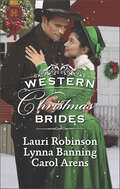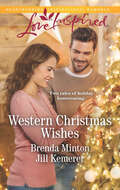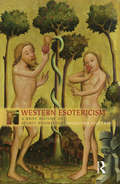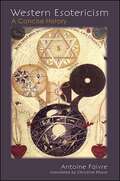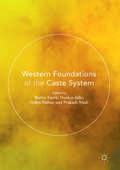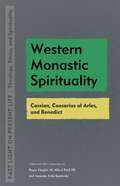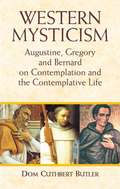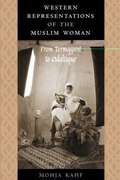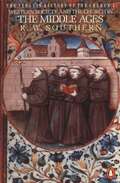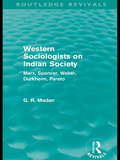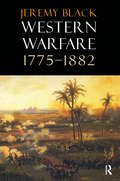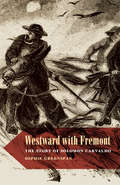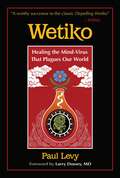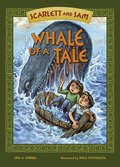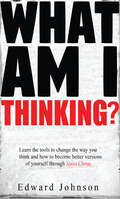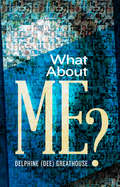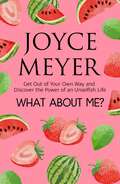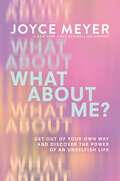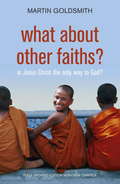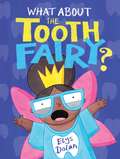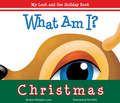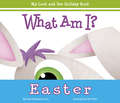- Table View
- List View
Western Christmas Brides: A Bride and Baby for Christmas\Miss Christina's Christmas Wish\A Kiss from the Cowboy
by Lynna Banning Lauri Robinson Carol ArensThree heartwarming stories of Christmas in the Wild West.A Bride and Baby for Christmas by Lauri RobinsonPregnant Hannah Olsen has made a list of Oak Grove’s eligible men. A list that Teddy White sees—and he’s not on it! Time for him to act so that both their Christmas wishes can come true.Miss Christina’s Christmas Wish by Lynna BanningDedicated new teacher Christina Marnell feels her heart race as she watches Ivan Panovsky chop wood for the school. She had ruled marriage out, but Christmas is a time when miracles can happen…A Kiss from the Cowboy by Carol ArensKitson James and Livy York both have secrets, but can their love overcome the lies they’ve told? A Christmas kiss might help…
Western Christmas Wishes
by Brenda Minton Jill KemererCombining family, faith, and country Christmas cheer, these two tales of heartwarming holiday romance make the perfect pair!Home is where the heart is in His Christmas Family when Laurel Adams comes back to Hope, Oklahoma, to discovers a foster kid and a seriously charming horse trainer living on her grandmother’s ranch. And in A Merry Wyoming Christmas, single mom Leann Bowden is starting over when she and her daughter are rescued from a snowstorm. Might the dashing cowboy be the Christmas gift they’re dreaming of?
Western Esotericism: A Brief History of Secret Knowledge (Religion In Culture: Studies In Social Contest And Construction Ser.)
by Kocku von StuckradEsotericism is the search for an absolute but hidden knowledge accessed through mystical vision, the mediation of higher beings, or personal experience. In Western cultural history esoteric approaches to religion have often been in conflict with - and suffered at the hands of - more established forms of religious belief and practice. 'Western Esotericism' presents a very broad and engaging history of the people and ideas which have shaped occult history from antiquity to today. Throughout the history of esotericism the dynamic of concealment and revelation has characterized the search for secret knowledge. Pursued both publically and privately, esotericism has come to influence more mainstream religious practice and culture and has significantly shaped our understanding of modernity. Today, esotericism continues to be practised by a range of both established and new religious movements. 'Western Esotericism' presents the essential guide to one of the most fascinating, provocative, and sustained of religious traditions.
Western Esotericism: A Concise History (SUNY series in Western Esoteric Traditions)
by Antoine FaivreWidely received in France, this brief, comprehensive introduction to Western esotericism by the founder of the field is at last available in English. A historical and pedagogical guide, the book is written primarily for students and novices. In clear, precise language, author Antoine Faivre provides an overview of Western esoteric currents since late antiquity. The bulk of the book is laid out chronologically, from ancient and medieval sources (Alexandrian hermetism, gnosticism, neoplatonism), through the Renaissance up to the present time. Its coverage includes spiritual alchemy, Jewish and Christian Kabbalah, Christian theosophy, Rosicrucianism, Illuminism, 'mystical' Free-Masonry, the Occultist current, Theosophical and Anthroposophical Societies, the Traditionalist School, and 'esotericism' in contemporary initiatic societies and in New Religious Movements. Faivre explores how these currents are connected, and refers to where they appear in art and literature. The book concludes with an annotated bibliography, which makes it an essential resource for beginners and scholars alike.
Western Foundations of the Caste System
by Martin Fárek, Dunkin Jalki, Sufiya Pathan and Prakash ShahThis book argues that the dominant descriptions of the ‘caste system’ are rooted in the Western Christian experience of India. Thus, caste studies tell us more about the West than about India. It further demonstrates the imperative to move beyond this scholarship in order to generate descriptions of Indian social reality. The dominant descriptions of the ‘caste system’ that we have today are results of originally Christian themes and questions. The authors of this collection show how this hypothesis can be applied beyond South Asia to the diasporic cultures that have made a home in Western countries, and how the inheritance of caste studies as structured by European scholarship impacts on our understanding of contemporary India and the Indians of the diaspora. This collection will be of interest to scholars and students of caste studies, India studies, religion in South Asia, postcolonial studies, history, anthropology and sociology.
Western Hemisphere: Geography Studies & Projects
by B. Ashbaugh D. Duby J. ReeseGeography textbook with a Christian emphasis.
Western Monastic Spirituality: Cassian, Caesarius of Arles, and Benedict (Past Light on Present Life: Theology, Ethics, and Spirituality)
by Roger Haight, Alfred Pach, and Amanda Avila KaminskiWestern Monastic Spirituality presents three authors as individuals, certainly, but also as textual informants who, like road markers, represent a line of the development of a Western monastic spiritual tradition. John Cassian (ca. 360–435) helped bring the wisdom of northern Egyptian ascetical life of the late fourth century to southern France in the early fifth century. Caesarius of Arles (468/470–542), drawing on his own monastic experience and Augustine’s monastic rule, composed a rule for a women’s monastery in the city of Arles. Not many years later, Benedict wrote the most influential rule in Western monasticism, one that still regulates the lives of monks today all over the world. These three texts, when looked at serially and together, offer a theology of monastic spirituality, an example of a relatively short but comprehensive early monastic rule, and a present day Benedictine interpretation of how Benedict’s monastic spirituality can be summed up in a short present day digest of his rule. Reflection on early Western monasticism retrieves some basic Christian spiritual values that should inform life today outside the monastery in a busy, secular culture.
Western Mysticism: Augustine, Gregory, and Bernard on Contemplation and the Contemplative Life
by Dom Cuthbert ButlerA growing number of readers are seeking to incorporate the contemplative in their busy lives, and this volume offers them expert advice. Drawn from the works of Saint Augustine, Saint Gregory and Saint Bernard, the writings form a coordinated body of doctrine by three of Western culture's most revered teachers of mystical theology. In addition to accounts of the writers' own religious experiences and their related theories, the book discusses speculative contemplation, defines mysticism and characteristics of Western mysticism, and contrasts contemplative and active lives. Filled with valuable suggestions and insights into the spiritual condition, this volume is a must for all students of mysticism.
Western Representations of the Muslim Woman: From Termagant to Odalisque
by Mohja KahfVeiled, secluded, submissive, oppressed--the "odalisque" image has held sway over Western representations of Muslim women since the Enlightenment of the eighteenth century. Yet during medieval and Renaissance times, European writers portrayed Muslim women in exactly the opposite way, as forceful queens of wanton and intimidating sexuality. In this illuminating study, Mohja Kahf traces the process through which the "termagant" became an "odalisque" in Western representations of Muslim women. Drawing examples from medieval chanson de geste and romance, Renaissance drama, Enlightenment prose, and Romantic poetry, she links the changing images of Muslim women to changes in European relations with the Islamic world, as well as to changing gender dynamics within Western societies.
Western Society and the Church in the Middle Age
by R. W. SouthernThe concept of an ordered human society, both religious and secular, as an expression of a divinely ordered universe was central to medieval thought. In the West the political and religious community were inextricably bound together, and because the Church was so intimately involved with the world, any history of it must take into account the development of medieval society. Professor Southern's book covers the period from the eighth to the sixteenth century. After sketching the main features of each medieval age, he deals in greater detail with the Papacy, the relations between Rome and her rival Constantinople, the bishops and archbishops, and the various religious orders, providing in all a superb history of the period.
Western Sociologists on Indian Society: Marx, Spencer, Weber, Durkheim, Pareto (Routledge Revivals)
by G. R. MadanOf the five major sociologists whose views on Indian society are assessed in this work, originally published in 1979, Marx and Weber made a special study of the subject and had something definite to say about the future of Indian society. Herbert Spencer was primarily concerned with the effects of colonial rule on India’s progress, while Durkheim and Pareto tended to observe Indian society from a comparative point of view. However, as this study shows, all five sociologists touched on two special aspects of Indian society – Indian religion and the caste system. The other features of Indian society which they discussed in their various writings range widely from marriage and family structure, through village communities and the social structure of cities, to political organization, the educational system, economic conditions, and the future progress of Indian society. Dr Madan demonstrates the correctness of Marx’s contention that the political subordination of India was the one great hindrance to the future progress of Indian Society. He points out, though, that Marx failed to see clearly the effects of the caste system on economic development, and shows that this aspect was more correctly assessed by Max Weber. On the other hand, in Dr Madan’s view, Weber’s observation that Indian religion was ‘other-worldly’ and therefore a great obstacle to progress in Indian society lacked incisiveness. By focusing on a neglected aspect of the writings of five of the great figures in sociology, the book gives a new insight into their work, and at the same time highlights many hitherto unrecognized facets of India’s complex social structure.
Western Warfare, 1775-1882
by Jeremy BlackThis is a wide-ranging and comprehensive survey of warfare from the outbreak of the American War of Independence to the British conquest of Egypt. Drawing on both primary and secondary sources this book offers an unrivalled account of civil and international conflicts involving Western powers, integrating both naval and land warfare. This book covers military capability as well as conflict, social and political contexts as well as weaponry, tactics and strategy. As well as examining such major conflicts as the Napoleonic Wars, the Crimean War, the American Civil War and the Wars of German Unification, this book redresses the imbalance of previous treatments by examining other important conflicts, for example, those in Latin America, as well as insurgency and counter-insurgency in Europe. This book's global perspective provides for a more reliable assessment of what constitutes military capability. In so doing, the author challenges the technological determinism and linear conceptions of developments in military science that continue to characterise much of military history. Instead the author reveals a much more complex dynamic, indeed going so far as to question the idea of 'modernity' itself. Bold in scope, and cutting-edge in its interpretations, this book offers much for the student, general reader and professional historian alike.
Westward with Fremont: The Story of Solomon Carvalho
by Sophie GreenspanIn 1853, Solomon Nunes Carvalho, proud descendant of a Sephardic Jewish family, accepted the invitation of Col. John Charles Fremont to accompany him on his fifth expedition of discovery through the Rockies to the Pacific Ocean. As the photographer and artist of the Fremont expedition, Carvalho provided the visual proof that the northern route through the Rockies could be used for the railroad that was being planned to link East and West. Fremont required this evidence to foil those who favored a route through the southern slaveholding states. Carvalho performed exceedingly well under extreme stress and danger. His photographs document the scenery and the Indian tribes that lived in the area between modern Kansas and Utah. His interest in science helped the colonel in recording the topography of the region and its meteorology. The paths of Carvalho and Fremont crossed again when the latter became the first Republican candidate for the presidency. To help the colonel, Carvalho published a book with an account of the expedition that ultimately became a best seller. Carvalho retained the pioneering instinct for the rest of his life, even in his later business career. He remains an honored figure in the history of the United States, typifying those who have served both the country at large and the Jewish community. Westward with Fremont tells the exciting story of one of the great legendary figures in American Jewish history.
Wet Earth and Dreams: A Narrative of Grief and Recovery
by Jane Lazarre"In the spring of 1995, the condition I seem to have been waiting for all my life finally struck me." So begins Jane Lazarre's account of her transforming battle with breast cancer. Following in the tradition of her critically acclaimed literary memoirs The Mother Knot and Beyond the Whiteness of Whiteness: Memoir of a White Mother of Black Sons, Lazarre brilliantly interweaves her experience of life-threatening illness with other stories of recent and past losses--most notably, that of her mother to breast cancer when Jane was a small child. From these memories and experiences, Lazarre crafts a story that is at once intensely intimate and universally healing.As she contends with the pain and many indignities of her treatment for cancer, Lazarre realizes that successful medical treatment will only be part of her healing process. Her own illness becomes the vehicle for coming to terms with key moments of loss and grief--the death of a beloved therapist from breast cancer, her brother-in-law's death from AIDS, a traumatic disappointment in her work life, and the unresolved pain of being a motherless child. The gift of Lazarre's writing is her ability to transform her narratives of grief and loss into a story whose power to heal lies in its ability to penetrate the unconscious and give voice to the elusive truths hidden there. Through her writing, Lazarre is able to embrace grief--even her own inarticulate grief as a child--and find her way through the story to a restored sense of wholeness.In Wet Earth and Dreams Jane Lazarre once again proves herself to be both companion and guide through some of the most difficult challenges life has to offer. As always, she draws strength not only from sustaining friendship and love, but also from her own faith in the power of storytelling to make bearable the seemingly unbearable. Lazarre's bravely and beautifully written account of grief, illness, and death is at the last a celebration of the redemptive possibilities of the creative spirit.
Wetiko: Healing the Mind-Virus That Plagues Our World
by Paul Levy• Explores how wetiko covertly operates both out in the world and within our minds and how it underlies every form of self-destruction, both individual and collective • Reveals how wetiko&’s power lies in our blindness to it and examines how people across the ages have symbolized wetiko to help see it and heal it • Examines the concept of wetiko as it appears in the teachings of the Kabbalah, Hawaiian Kahuna shamanism, mystical Christianity, and the work of C. G. Jung In its Native American meaning, wetiko is an evil cannibalistic spirit that can take over people&’s minds, leading to selfishness, insatiable greed, and consumption as an end in itself, destructively turning our intrinsic creative genius against our own humanity. Revealing the presence of wetiko in our modern world behind every form of destruction our species is carrying out, both individual and collective, Paul Levy shows how this mind-virus is so embedded in our psyches that it is almost undetectable--and it is our blindness to it that gives wetiko its power. Yet, as Levy reveals in striking detail, by recognizing this highly contagious mind parasite, by seeing wetiko, we can break free from its hold and realize the vast creative powers of the human mind. Levy explores how artists, philosophers, and spiritual traditions across the ages have been creatively symbolizing this deadly pathogen of the psyche so as to help us see it and heal it. He examines the concept of wetiko as it appears in the teachings of the Kabbalah, Hawaiian Kahuna shamanism, Buddhism, and mystical Christianity and through esoteric concepts like egregores, demons, counterfeiting spirits, and psychic vampires. He reveals how visionary thinkers such as C. G. Jung, Sri Aurobindo, Philip K. Dick, Colin Wilson, Nicolas Berdyaev, and Rene Girard each point to wetiko in their own unique and creative way. He explores how the projection of the shadow self--scapegoating--is the underlying psychological mechanism fueling wetiko and examines wetiko in the context of the Covid-19 pandemic, showing that we can reframe the pandemic so as to receive the lessons and opportunities embedded in it. Revealing how the power of imagination can cure the wetiko mind-virus, Levy underscores how important it is for each of us to bring forth the creative spirit within us, which helps shed the light of consciousness on wetiko, taking away its power over us while simultaneously empowering ourselves.
Whale of a Tale (Scarlett and Sam)
by Eric A. KimmelScarlett and Sam are back again in a twist on the biblical adventure tale of Jonah and the whale. When the twins take Grandma Mina's special carpet to be cleaned and repaired, they encounter a strange person who steps on the rug and disappears! Scarlett and Sam follow him back through time to ancient Israel, where they find themselves on a ship. Why have they been sent back in time to this ship on a stormy sea? Soon the answer comes. The man is Jonah and they're in the story of Jonah and the whale! Sam and Scarlett know that they must do what the ship's captain cannot—get Jonah overboard—even if that means that they must go overboard, too!
What AM I Thinking?
by Edward JohnsonLearn the tools to change the way you think and how to become better versions of yourself through Jesus Christ.
What About Me?
by Delphine (Dee) GreathouseAs believers, we spend a great deal of time praying for ourselves and our circumstances. We ask: &“Lord, what about me? I have all these needs. What about me?&” Author Dee Greathouse says God wants to ask us the same question: &“Child, what about Me? I am the answer you need. The Me I have placed inside you allows you by faith to take advantage of the unique life I have given you.&” You will learn from this personal testimony by Dr. Greathouse that miracles happen every day—if you trust in the sovereign will of God and believe His Word. Whether your need is healing, financial, or miracle power, she will show you that in God&’s will, design, and plan for your life, all your needs will be met when you turn them over to the Lord.
What About Me?: Get Out of Your Own Way and Discover the Joy of an Unselfish Life
by Joyce MeyerAs we go about our daily lives, there is a little voice in our minds that's always asking, 'What about me?' Maybe your voice says, 'When is it my turn to be noticed at work?' or 'When will someone in this family do something for me?' That voice may be whispering to you about your finances, your job, or your friends, but it is always encouraging you to think about something you don't have. And sadly, social media and culture in general lead us to focus on this world's concept of happiness and success - but does it work? Could you be sabotaging your own joy, your purpose, your success? What could you do to get out of your own way? And most importantly, what is God's definition of success? The Bible tells us over and over that the true source of meaning and happiness is a life focused on God and on serving others. Instead of asking when it will be our turn to get a raise, be recognised, or finally make it big, it's time to discover the source of true and lasting of happiness and satisfaction. By walking on this path, we will have more joy and a closer relationship with God than we could ever imagine!
What About Me?: Get Out of Your Own Way and Discover the Power of an Unselfish Life
by Joyce MeyerExperience the true satisfaction and power of living unselfishly with #1 New York Times bestselling author and renowned Bible teacher Joyce Meyer. As we go about our daily lives, there is a little voice in our minds that&’s always asking, &“What about me?&” Maybe your voice says, &“When is it my turn to be noticed at work?&” or &“When will someone in this family do something for me?&” That voice may be whispering to you about your finances, your job, or your friends, but it is always encouraging you to think about something you don&’t have. And sadly, social media and our comparison culture lead us to focus on this world&’s concept of happiness and success—but does it work? Could you be sabotaging your own joy, your purpose, your success? What could you do to get out of your own way? And most importantly, what is God&’s definition of success? The Bible tells us over and over that the true source of meaning and happiness is a life focused on God and on serving others. Instead of asking when it will be our turn to get a raise, be recognized, or finally make it big, it&’s time to discover the source of true and lasting of happiness and satisfaction. By walking in this path, we will have more joy and a closer relationship with God than we could ever imagine! A study guide, as well as a Spanish edition,¿Y qué hay de mí?, are also available for purchase.
What About Other Faiths?
by Martin GoldsmithToday our multi-cultural society forces Christians to be aware of those with other, equally strong religious convictions.In this challenging and popular book, Martin Goldsmith answers all the hard questions facing Christians in this area, drawing on both biblical material and his own expertise as someone with wide cross-cultural experience.A brief explanation of other religions' concept of God, revelation and salvation is included, and the question of whether it is right to evangelise those of other faiths is tackled, along with a look at practical methods that can be used.A brand new chapter asks 'Why is Jesus so special?' when each of the world religions have central figure to worship.
What About Other Faiths?
by Martin GoldsmithToday our multi-cultural society forces Christians to be aware of those with other, equally strong religious convictions.In this challenging and popular book, Martin Goldsmith answers all the hard questions facing Christians in this area, drawing on both biblical material and his own expertise as someone with wide cross-cultural experience.A brief explanation of other religions' concept of God, revelation and salvation is included, and the question of whether it is right to evangelise those of other faiths is tackled, along with a look at practical methods that can be used.A brand new chapter asks 'Why is Jesus so special?' when each of the world religions have central figure to worship.
What About The Tooth Fairy?
by Elys DolanSanta has Christmas, Cupid has Valentine's Day and the Easter Bunny has . . . well, Easter! But why doesn't the Tooth Fairy have a special day of her own?!Everybody knows the Tooth Fairy is the best in the business. But although she loves her job, sometimes she can't help but wonder why she doesn't have a day of her own, like all her very famous friends . . .With some expert advice from Father Christmas, The Easter Bunny, Cupid and Jack O'Lantern, Toothy tries to start her own 'Tooth Day'! But no matter how hard she tries, their ideas for Tooth Day just don't feel right.Soon the Tooth Fairy learns that for her day to be really special, she's got to do it her own way. A hilarious new story featuring everyone's favourite magical characters, with an important message about being yourself. Written and illustrated by the creator of Super Snail!
What Am I? Christmas
by Anne Margaret Lewis Tom MillsFor young children, a swipe-and-reveal look at what makes Christmas special. From Santa to a Christmas tree, this is a sure hit for little ones as they guess, "What Am I?" and lift the flap to find out!
What Am I? Easter
by Anne Margaret Lewis Tom MillsFor young children, a swipe-and-reveal look at what makes Easter special. From Spring flowers to the Easter parade, this is a sure hit for little ones as they guess, "What Am I?" and lift the page to find out!
